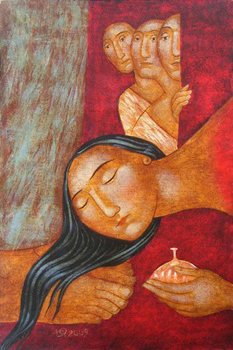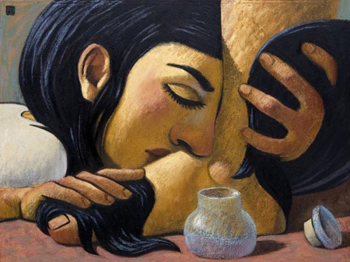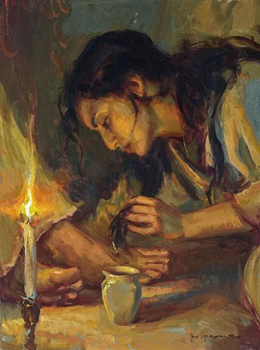For Sunday April 7, 2019
Lectionary Readings (Revised Common Lectionary, Year C)
Isaiah 43:16-21
Psalm 126
Phillippians 3:4b-14
John 12:1-8
On this fifth Sunday in Lent, as our thoughts turn increasingly towards Jesus’s suffering, John’s Gospel offers us a brief respite. In fact, all four Gospels offer it — the moving story of a woman who kneels at a crowded dinner table, breaks an alabaster jar filled with priceless perfume, and dares to love Jesus in the flesh. Hands to feet. Hair to skin. Each writer frames the event differently, to suit his own thematic and theological concerns, but the story at its core remains one of the most sensual and powerful in the New Testament. If it doesn't give us pause during this Lenten season, we're not paying attention.
In John’s version, the woman is Mary of Bethany, the sister of Martha and the newly resurrected Lazarus. The two sisters host a dinner party for Jesus, and it’s during the festivities that Mary breaks open her jar, anoints Jesus with spikenard (a scented oil worth a year’s wages) and wipes his feet with her hair. As the musky fragrance of the oil fills the house, Judas rebukes Mary for her misguided generosity: “Why was this perfume not sold for three hundred denarii and the money given to the poor?” But Jesus silences him: “Leave her alone. She bought it so that she might keep it for the day of my burial. You always have the poor with you, but you do not always have me.”
It’s a complicated story, not least because it raises thorny questions about poverty, piety, and stewardship. But it’s also a rich story, full of treasures we can carry with us as we travel with Jesus towards Jerusalem. As I’ve pondered Mary’s gesture of love this week, here are some of the treasures I’ve discovered:
1. The treasure of the body: What happens between Jesus and Mary in this narrative happens skin to skin. Mary doesn’t need to use words; her yearning, her worship, her gratitude, and her love are enacted wholly through her body. Just as Jesus later breaks bread with his disciples, Mary breaks open the jar in her hands, allowing its contents to pour freely over Jesus’s feet. Just as Jesus later washes his disciples’ feet to demonstrate what radical love looks like, Mary expresses her love with a humble physical act. Jesus, rather than shunning her intimate gesture, receives Mary’s gift into his own body with gratitude, tenderness, pleasure, and blessing. The holy sacraments here are skin, salt, sweat, and tears. The instruments of worship are perfumed feet and unbound hair. This is not an abstract piety of the mind; this is physical extravagance. What writer Mary Gordon calls, "A Sabbath of the skin."
 |
As I contemplate this treasure, I realize once again that I’m the product of a culture that treats bodies with ambivalence and scorn. Most of the time, I see my own body as something to shrink, starve, conquer, or tame. I see its flaws so much more clearly than I see its God-ordained dignity and beauty. Rarely do I recognize it as a vehicle for worship, love, hospitality, and grace. But Mary’s gesture reminds me that if I won’t see my own body as God's temple, if I won't embrace it as pleasing and delightful to its Creator, I won’t be able to embrace anyone else’s. We are people of the Incarnation, called to break bread, share wine, shed tears, and wash feet. During this Lenten season, can we learn to see our embodied lives, our sensory lives, as fully implicated in our lives with God? Can we move past contempt, squeamishness, and fear, and offer him our whole selves?
2. The treasure of beauty: In Mark’s version of the story, Jesus tells Mary’s critics that her gesture is “a beautiful thing,” worthy of honor and remembrance. Over and against Judas’s pragmatism, Jesus celebrates the fragrant and the delectable. In doing so, he gives us permission to savor the good gifts of life on this fragile but gorgeous earth — the pleasures of our senses, the beauties of nature, and the fruits of human creativity and artistry.
I didn’t grow up in a Christian tradition that put much stock in beauty — liturgical or other. If anything, beauty was viewed with suspicion as frivolous and distracting. Real piety resided in words like mission, purpose, belief, and faith. So I'll be honest; Judas’s criticism gives me pause. Shouldn’t we be sensible? Spare? Cautious? Shouldn’t we be guided foremost by creeds, strategic plans, and measured principles? Aren't we supposed to balance our budgets? No. Not always. Not at the expense of the life-giving and the beautiful.
 |
Is Mary’s gift lavish? Yes. It is “useless” in the practical-minded economy Judas brings to the table? Yes. Is it efficient, orderly, or logical? No. And yet Jesus cherishes and blesses it. As Mary Gordon puts it: “In the moment of the washing of the feet, Jesus insists that beauty matters: that the aesthetic can take precedence over the moral.” Think about it this way: in times of peril, pain, or trouble in your own life, what has comforted you the most? What has carried you through? The platitudes of a pragmatist? Or the lavish and “useless” gestures of someone who loves you?
3. The treasure of now: Jesus responds to Judas’s criticism with a comment that might sound callous: “You always have the poor with you, but you do not always have me.” What is Jesus saying? That the poor don’t matter? That we should accept poverty as inevitable and unfixable? I don’t think so. In fact, many commentators argue that Jesus’s reference here is to Deuteronomy 15:11, whose message about poverty and generosity is crystal clear: “There will always be poor people in the land. Therefore I command you to be openhanded.” In other words, the call to care for the poor is constant. It never ceases.
 |
So what is it about Mary’s extravagance that merits Jesus’s blessing, and what is it about Judas’s criticism that earns Jesus’s rebuke? Mary responds to the call of love in the moment. In the now. Knowing what Jesus is about to face; knowing that he’s in urgent need of companionship, comfort, and solace; knowing that the time is short to express all the gratitude and affection she carries in her heart, Mary acts. Given the choice between an abstracted need (the poor “out there”) and the concrete need that presents itself at her own doorstep, around her own dinner table, Mary chooses the here and now. She loves the body and soul who is placed in her presence. In doing so, she ends up caring for the one who is denied room at the inn — even to be born. For the one who has no place to lay his head during his years of ministry. For the one whose crucified body is laid in a borrowed tomb. In other words, it is the poor Mary serves when she serves Jesus. Just as it is always Jesus we serve when we love without reservation what God places in front of us, here and now.
Lutheran minister Reagan Humber puts it this way: “What won’t always be with us is the opportunity to see God in whatever and whomever stands in front of us right now. The kingdom of God is here. Right now is the moment when God can break our hearts. The love of God is the grace of now.”
The treasure of the body. The treasure of beauty. The treasure of now. So much is given to us in this Gospel story. What will we do with it all as we set our faces towards Jerusalem? Will we choose the measured risk or the extravagant gesture? In the presence of an overflowing heart, will we honor "useless" gestures as sacred to God, or hold back in contempt and suspicion? What will guide us as we contemplate the cross — the theological platitude, or the fragrance of Christ? That very important jar we're hanging onto at all costs — when and for whom will we break it?
The time is short. The cross awaits. Here is Jesus, asking the hard question one more time: What are you going to do, while you still have me?
Notes on Art:
1. Julia Stankova is an artist from Bulgaria
2. “Anointing His Feet, #2” by Wayne Forte
3. “Forgiveness,” by Daniel Gerhartz
Image credits: (1–3) GlobalWorship.tumblr.com.





